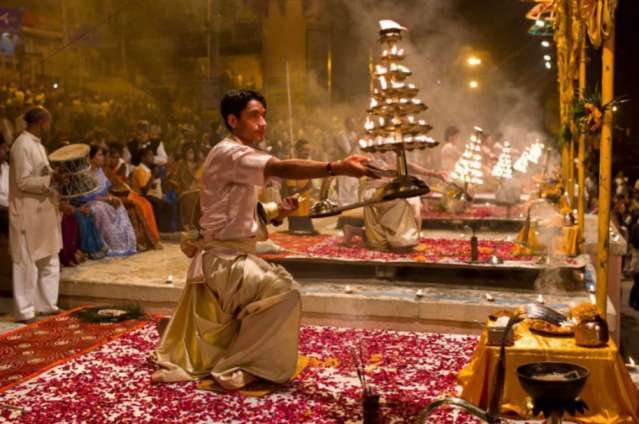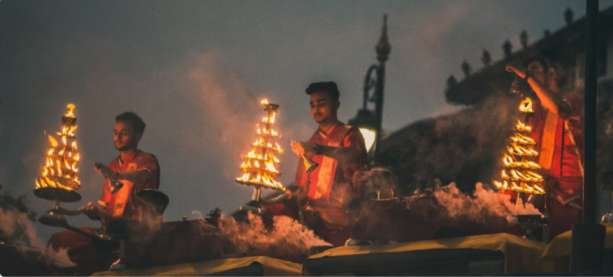Discovering the Best timing for Ganga Aarti in Varanasi. Hindus believe that the Ganga, revered as the holiest river in Hindu mythology, has the power to cleanse one’s sins with a single dip. At the ghats of Varanasi, throngs of devotees gather to perform “Snaan” (ritual bathing) in its sacred waters. For their safety, chains and poles are installed to prevent anyone from being swept away by the river’s strong current. This ritual is not only a testament to the devotees’ faith but also a gesture of deep reverence for the river.

Capturing the Beauty of Ganga Aarti
Every evening, the ghats come alive with the mesmerizing spectacle of the Ganga Aarti. The most renowned of these ceremonies takes place at Dashashwamedh Ghat, situated adjacent to the Kashi Vishwanath Temple. Other notable locations for witnessing the Aarti include Assi Ghat and Rajendra Prasad Ghat.
As the time for the Aarti approaches at Dashashwamedh Ghat, the blowing of a Shankh (conch) halts the bustling activity of people who are securing the best viewing spot. This sound signals the beginning of the Aarti and captures the attention of everyone present. They place a statue of Goddess Ganga at the center of one of the raised platforms, symbolizing the river’s divine status. The ceremony unfolds with the rhythmic sound of bells, chants, and the lighting of incense sticks and Diyas (lamps).
The priests, with their synchronized movements, conduct the Aarti in a manner that is both captivating and spiritually uplifting. Their years of practice and unwavering devotion ensure the safety of the lamps, despite the seemingly precarious nature of the ritual. For 45 minutes, the ceremony continues, holding the audience in rapt attention, making it nearly impossible to look away.
The Ganga Aarti at Varanasi has gained nationwide acclaim for its beauty and spiritual significance. Regardless of one’s religion, this ceremony is a must-see when visiting Varanasi, offering an unforgettable experience of devotion and cultural heritage.
Morning Ganga Aarti: Embracing Spiritual Enrichment
Subah-E-Banaras:
- The morning aarti in Varanasi is called Subah-E-Banaras.
- It began as an initiative by the State Government of Uttar Pradesh in 2014.
- Considered the ideal way to start a morning in Varanasi.
Aarti Ceremony:
- The ceremony begins with the chanting of Vedic verses.
- Followed by the Ganga aarti, paying tribute to the four basic elements: earth, water, sky, and fire.
Comparison with Evening Aarti:
- The morning aarti is similar to the evening aarti performed at Dashashwamedh Ghat.
- It allows for clearer viewing and a closer experience due to fewer attendees.
Post-Aarti Musical Performance:
- After the aarti, classical musicians from Banaras Gharana perform.
- Banaras Gharana, established by Pandit Ram Sahai 200 years ago, is one of the six common styles of playing the tabla.
- Gharanas are important social organizations in northern India, each specializing in a craft of music or dance.
- Pandit Ram Sahai was trained at Lucknow Gharana before founding Banaras Gharana.
Tips for Visiting Varanasi and Watching the Ganga Aarti
Vital Information For Visitors
Address: Ganga Aarti, Dashashwamedh Ghat, Near Vishwanath Temple, Varanasi, UP.
Open & Close:
Open on all days: 05:30 AM to 12:00 PM
04:00 PM to 09:00 PM
Entry Fees: Free
Duration: 45 minutes
Dedicated To: River Ganges worshipped as Mother Ganga
Aarti Schedule: Daily evening
Aarti Time Winter: 06:00 PM
Aarti Time Summer: 07:00 PM
Must-Visit Locations:
- Dashashwamedh Ghat for the evening Ganga Aarti.
- Assi Ghat for the morning Subah-E-Banaras Aarti.
Cost:
- Both aartis are free of charge.
- Voluntary offerings are accepted during the evening Aarti but are not compulsory. You can donate any amount you can afford.
Ganga Aarti timing:
- Arrive at least an hour early to secure a good spot, as the ghat becomes very crowded quickly.
Ganga Aarti Morning timing :
- There is no rush for the morning Aarti, but it’s best to experience Subah-E-Banaras from the beginning. Go to bed early the night before to wake up refreshed and on time.
Crowd and Safety:
- Dashashwamedh Ghat is the most crowded, so be extra cautious with your belongings.

